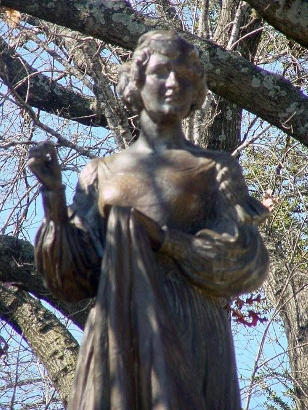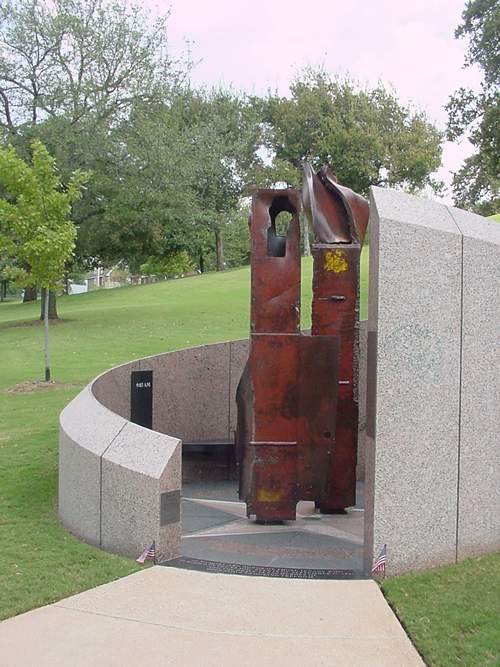Texas State Cemetery, Austin Texas. (original) (raw)
The cemetery can be entered through several gates, but we suggest the main entrance on Navasota Street. Dedications and information have been artistically sandblasted into the natural sandstone walls.
Main entrance to the Texas State Cemetery
Photo courtesy Sarah Reveley, January 2006
A small museum at the entrance houses artifacts (mostly personal items of former governors) and gives information on other notable early cemeteries around Texas. A detailed printed guide is available as you begin your walking tour. A detailed living guide is available for groups with prior arrangement.
The Texas State Cemetery is a mandatory stop for anyone with the slightest interest in Texas history. This pantheon of Texas heroes, near-heroes and dubious heroes is a sort of living history book - except that there are no pages and only the caretakers and squirrels are living.
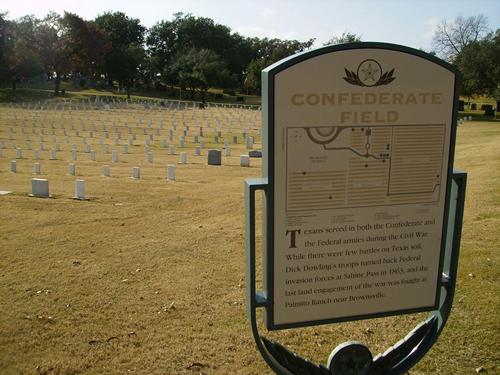
The resemblance to Arlington National Cemetery is immediately apparent due to the uneven terrain and row upon row of plain white tombstones (recently cleaned and reinstalled). The stones lack the rigid uniformity of Arlington, but Texas has always avoided rigid uniformity.
While many of the dignitaries had their remains exhumed and reburied here; it wasn't necessary to move the graves of the rank and file soldiers since Austin had been the host city for the State Confederate Veteran's home.
The cemetery would not be the exceptional historical garden that it is today if it were not for the tireless efforts of Louis Kemp. Kemp was a state employee who worked for the Texas Department of Transportation and it was his idea to gather the bodies of men and women who had contributed to Texas' history. Kemp, too, is buried on the grounds in appreciation of his efforts.
Some notable residents ›
Texas State Cemetery Historical Marker ›
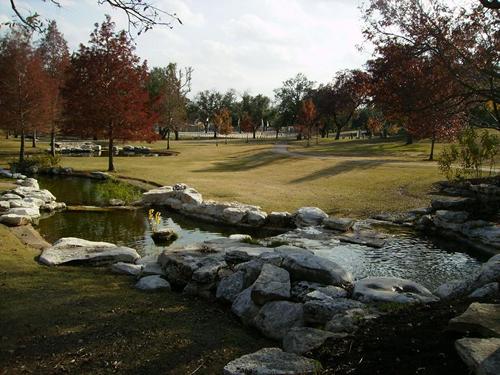
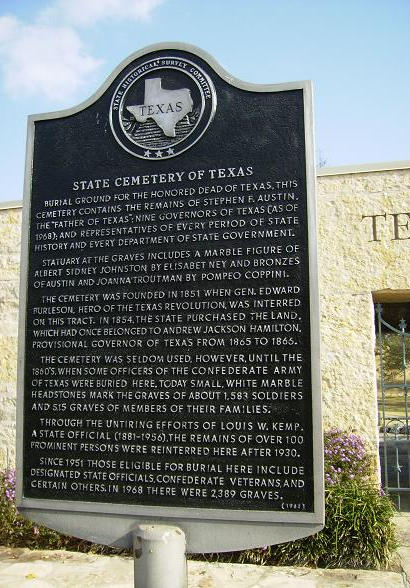
State Cemetery of Texas Historical Marker
909 Navasota St., Austin TX
Photo courtesy Sarah Reveley, January 2006
Historical marker:
State Cemetery of Texas
Burial Ground for the Honored Dead of Texas, this Cemetery contains the remains of Stephen F. Austin, the "Father of Texas"; nine governors of Texas (as of 1968); and representatives of every period of State history and every department of State government.
Statuary at the graves includes a marble figure of Albert Sidney Johnston by Elisabet Ney and bronzes of Austin and Joanna Troutman by Pompeo Coppini.
The Cemetery was founded in 1851 when Gen. Edward Burleson, hero of the Texas Revolution, was interred on this tract. In 1854, the State purchased the land, which had once belonged to Andrew Jackson Hamilton, provisional governor of Texas from 1865 to 1866.
The Cemetery was seldom used, however, until the 1860's, when some officers of the Confederate Army of Texas were buried here. Today small, white marble headstones mark the graves of about 1,583 soldiers and 515 graves of members of their families.
Through the untiring efforts of Louis W. Kemp, a State Official (1881-1956), the remains of over 100 prominent persons were reinterred here after 1930.
Since 1951 those eligible for burial here include designated State Officials, Confederate Veterans, and certain others. In 1968 there were 2,389 graves.
(1968)
Some noteworthy residents of the cemetery and their monuments follow:
 |
An unusual pose for Stephen Fuller Austin TE Photo |
|---|
Stephen F. Austin
The statue of Stephen F. Austin that commands the hill in the southwest corner is by the Italian born Pompeo Coppini. Coppini had a studio in San Antonio for many years and his contributions to Texas sculpture are spread across Texas. The somewhat unusual pose of Austin's statue is due to it's original planned location. It was originally to be placed at Congress Avenue and the river. His outstretched arm is not meant as a salute, but to show off the main street of the city that bears his name.
[See Remembering Austin by Mike Cox]
Bigfoot WallaceThe headstone for William Alexander Anderson Wallace sits very near the base of the Stephen F. Austin Statue. Wallace, for some reason doesn't have his Christian names inscribed on his tombstone. Length may have had something to do with it. Wallace's Texas adventures were exaggerated, inflated and twisted into outrageous legend - and that was just when he would introduce himself.
He arrived in Texas to avenge a brother and cousin who were killed in the massacre of Fannin and his men at Goliad. He joined the Somervell/ Mier expeditions and participated in the black bean death lottery where he drew a white bean - and was spared. He and the other "winners" were then taken on a well-escorted tour of Mexican prisons.
After his release he carried the mail from San Antonio to El Paso and eventually retired to the banks of the Medina River where his neighbors renamed the town of Bigfoot, Texas in his honor.
[See Texas Personality: Bigfoot Wallace]
The Joanna Troutman Statue
is also a Coppini work
TE Photo
T
routman: This statue of the woman who has been called the Betsy Ross of Texas was also the work of Coppini. Ms. Troutman had died in her native Georgia (without ever visiting Texas) and her remains were moved here in 1913.
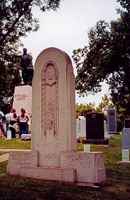 |
A pair of ex-governors TE Photo |
|---|
James & Miriam Fergusons The Fergusons: The only husband-wife team of governors Texas has ever had. Their beautiful stone is situated not far from the more minimalist gravesite of their nemesis Dan Moody (and wife). Moody defeated Miriam "Ma" Ferguson in the 1926 election. Moody, a World War I veteran, served as Texas Attorney General and investigated the Ferguson's questionable awarding of highway contracts.
Edmund Jackson Davis Edmund Jackson Davis, the Reconstruction Governor has his grave marked by the tallest marker in the cemetery (erected by his brother). Probably the most reviled man ever to be in the Governor's mansion - Davis would tell you if he could - that the feeling (at least toward Confederates) was mutual. The obelisk's position and size is meant to irritate the Confederate dead. His reluctance to leave the Governor's Mansion after his term was up is another embarrassingly true Texas legend.

General Albert Sidney Johnston's Tomb
TE Photo, January 2007
General Albert Sidney Johnston The unusual recumbent statue of Albert Sidney Johnston (inside the tomb above) was carved by the "Madwoman of Austin" Elizabet Ney. Her model for the sarcophagus is on display in her former studio/ home in Austin's Hyde Park district.
Johnston was killed at Shiloh after being shot in the femoral artery. He bled to death while still mounted and giving orders. Johnston was a special hero to Texans since he had served as Texas Secretary of War under Lamar.
His glass-enclosed grave shed (with a modern Plexiglas cover) is the most elaborate structure/shrine in the cemetery.

Statue of Colonel Albert Sidney Johnson
TE Photo, April 2003
 |
John Wharton in Bronze TE Photo |
|---|
John Wharton The bust of John Wharton is not far from that of General Johnson, however Wharton didn't die on the battlefield. He was killed in a Houston tavern by a soldier who thought Wharton had wronged him. The bust is by noted sculptor Enrico Cerracchio - the artist of Sam Houston's Equestrian statue in Houston's Hermann Park.
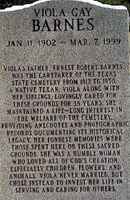 |
A Devoted Caretaker A marker in appreciation of Viola Gay Barnes |
|---|
 |
A few of the other markers of Texas Governors, statesmen and characters TE Photo |
|---|
After entering the main gate of the cemetery the memorial is about 150 yards directly in front of you across the pool.
Photo by John Troesser September 2004
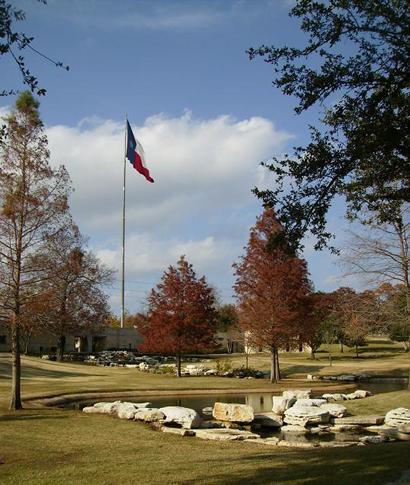
This concludes our visit to the Texas State Cemetery. We have covered only a portion of the grounds and encourage those visiting Austin to include time for the State Cemetery.
Texas' shortest highway - SH 165 runs through the State Cemetery.
Related Articles
- Sailor's Burial by Bob Bowman (from "All Things Historical")
Texas Historical Commission archeologists discovered the sailor's skeletal remains during the 1996 excavation of French explorer Robert Cavelier, Sieur de La Salle's ship, the Belle, which sank in Matagorda Bay in 1686. His remains are now the oldest ever buried in the State Cemetery. - The Wrong Grave by Bob Bowman (from "All Things Historical")
Among the towering monuments in the Texas State Cemetery -- the final resting place for Stephen F. Austin and other state titans -- lies the grave of John Alexander Greer of San Augustine, a Republic of Texas senator, a lieutenant governor, and a one-time candidate for governor. But in East Texas, where Greer spent his life, there is the lingering question if his bones really lie beneath his Austin tombstone. - Stephen Williams (From Patriots by Mike Cox)
The final Revolutionary War veteran who fought for Texas was buried here. - Remembering Austin by Mike Cox
- Bigfoot Wallace
- September 11th Memorial
Texas Escapes, in its purpose to preserve historic, endangered and vanishing Texas, asks that anyone wishing to share their local history, stories, landmarks and recent or vintage photos, please contact us.

